Have you met your salary standards?
Written by: Nick Zurick, Pantera
Translated by: AididiaoJP, Foresight News
Key Findings
Last year, 3% of people received their salaries in cryptocurrency, and this year that percentage has tripled to 9.6%. Stablecoins USDC and USDT dominate, with most people receiving their salaries in cryptocurrency opting for USDC.
Will the cryptocurrency industry return to in-person work? Probably not, but the proportion of people working in offline offices has increased fourfold (to 6%).
In terms of median salary, having an MBA does not guarantee a higher salary in the Web3 space. In fact, salaries have slightly decreased.
In terms of median salary, women earn more than men in marketing, operations, and business development, but men dominate in engineering and executive positions.
Salaries for engineering positions at all levels have generally increased, with significant growth in junior and mid-level positions: junior engineers up 25.6%, mid-level engineers up 14.49%, and senior engineers up 4.9%.
Methodology Overview
Our survey data comes from dozens of startups located in different regions, as well as information collected from hundreds of participants in the cryptocurrency community, covering a wide range of job types. This data reflects various stages from seed rounds to later-stage companies, involving multiple fields such as DeFi, CeFi, and gaming.
In this report, "executives" refer to leaders and founders, "engineering" refers to all technical positions, and "operations" broadly refers to roles in customer service, marketing, strategy, etc.
The Pantera team has made efforts to anonymize the dataset. In some cases, we excluded: significant outliers, incorrectly formatted submissions, and information that could potentially expose specific projects. We standardized the data based on factors such as experience level, geographic location, company sector, and job function.
In the following report, we will selectively combine this survey data with the previous survey data from December 2023 to provide a more comprehensive analysis. Unless otherwise stated, all salary data is presented in median values in US dollars.
Respondent Profile
Our dataset includes over 1,600 responses, with 99% of respondents being professionals from the cryptocurrency industry.

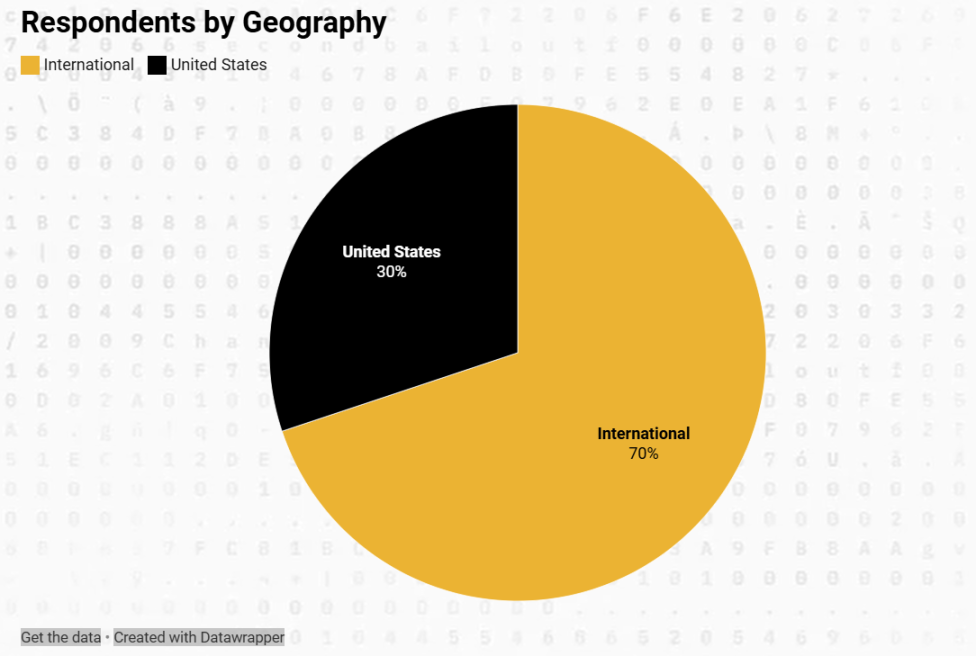
The data covers 77 different countries, with 72% from regions outside the United States and the remaining 28% from the United States.
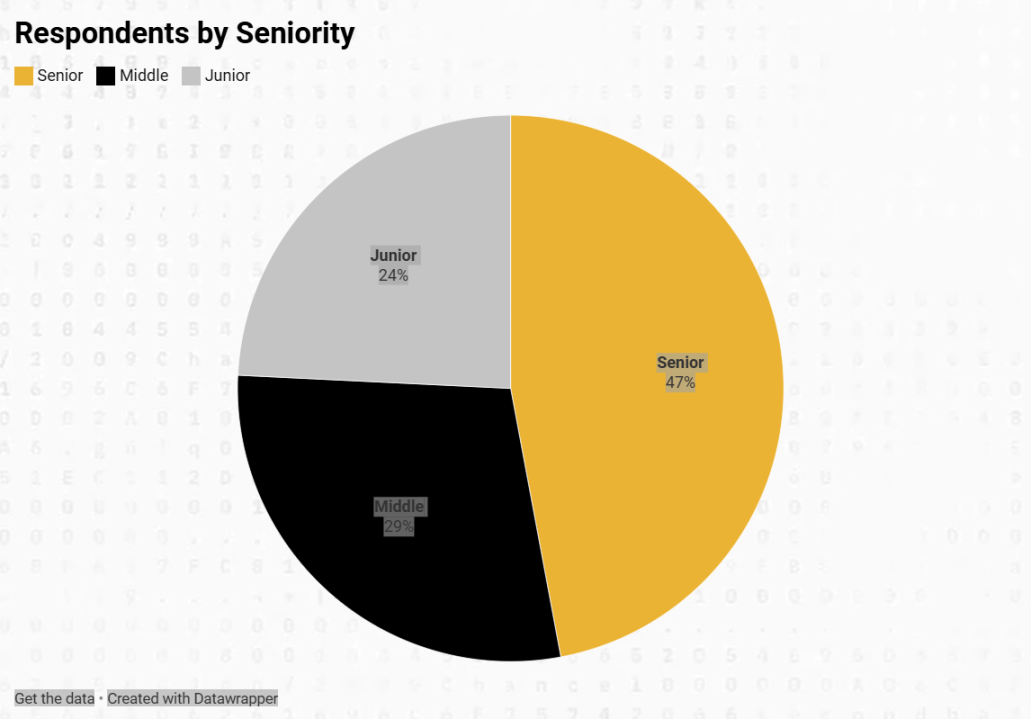
The survey results skew towards experienced groups, with most submitters classified as "senior" staff (i.e., with over six years of work experience). The classification of job levels is as follows: junior (1-3 years experience), mid-level (3-6 years experience), senior (over 6 years experience).
By Function
Job functions include engineering, operations, marketing, design, business development, product management, executive leadership, finance and accounting, legal, etc.
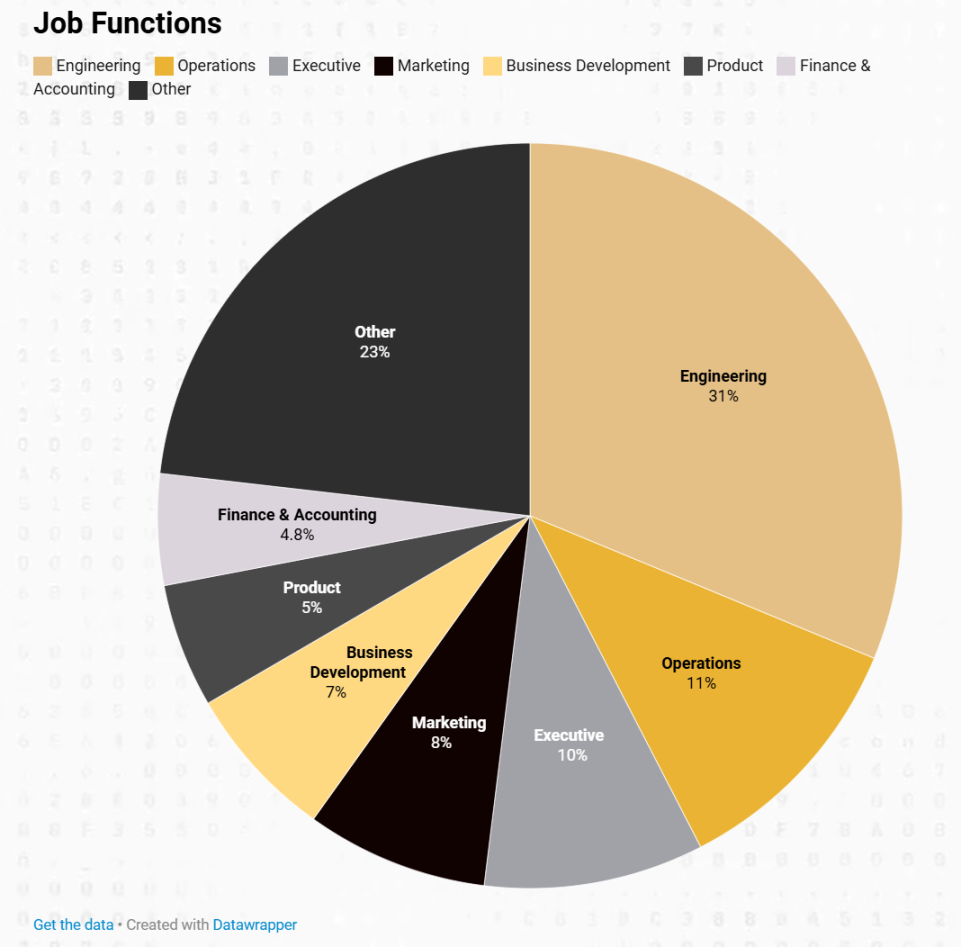
By Sector
These professionals are distributed across multiple sectors, including DeFi, CeFi, infrastructure, consumer, NFT, and gaming.
By Stage
The companies surveyed vary in size, from teams with fewer than five employees to companies with hundreds of employees, covering stages from seed rounds to growth stages. Below is the distribution of respondents by stage.
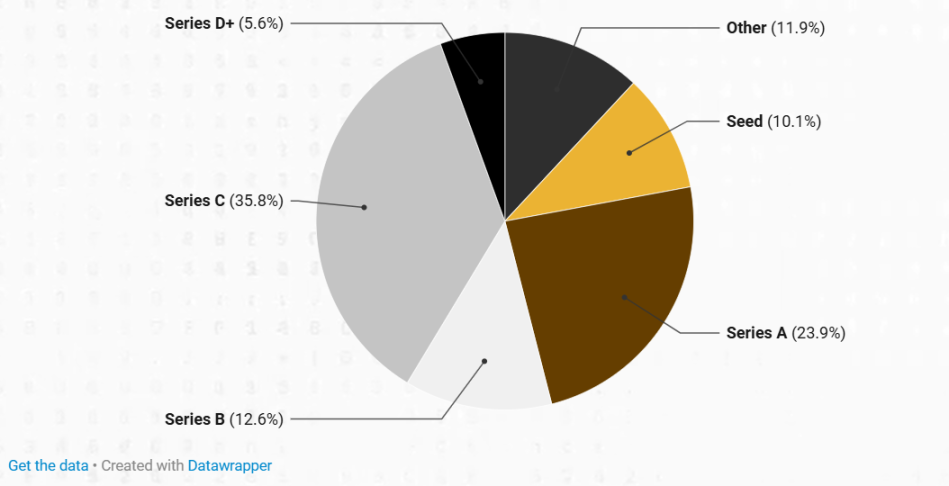
Global Distribution
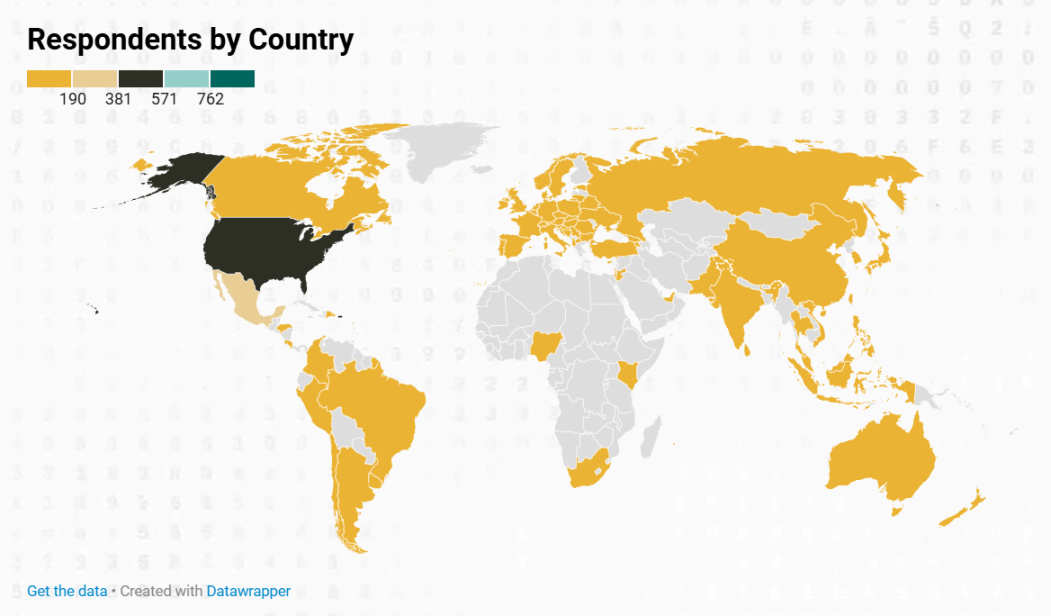
Remote Work Trends
As part of the annual blockchain salary survey, we collected data on workplace arrangements within the industry. Below are the work preferences and trends for 2024 compared to 2023.

● Will the cryptocurrency industry return to in-person work? Although the ecosystem remains predominantly remote, the proportion of in-person work has significantly increased, rising from 1.5% in 2023 to 6% in 2024. This indicates that organizations are gradually calling for employees to return to the office.
● The hybrid work model remains stable: the proportion of those adopting a hybrid work model has remained largely unchanged, adjusting slightly from 10.6% in 2023 to 11% in 2024. This stability suggests that hybrid work is becoming the norm within the industry.
● Remote work still dominates: despite the increase in in-person work, the blockchain industry remains predominantly remote, with 82% of respondents working fully remotely in 2024. Although this is a decrease of 5.8 percentage points from 2023, remote work remains the cultural and operational core of the field.
The slight rise in office and hybrid work models indicates that the "Return to Office" (RTO) trend is impacting the blockchain ecosystem. However, the decentralized philosophy of blockchain is still reflected in its work culture, with remote work remaining the preferred choice for most organizations.
In the Web2 or "traditional tech" space, recent surveys show that about 70-80% of tech workers still prefer remote or hybrid models. Companies like Meta, Google, and Amazon have begun implementing stricter office policies, but employee resistance has slowed the pace of implementation.
Gender Distribution of Respondents
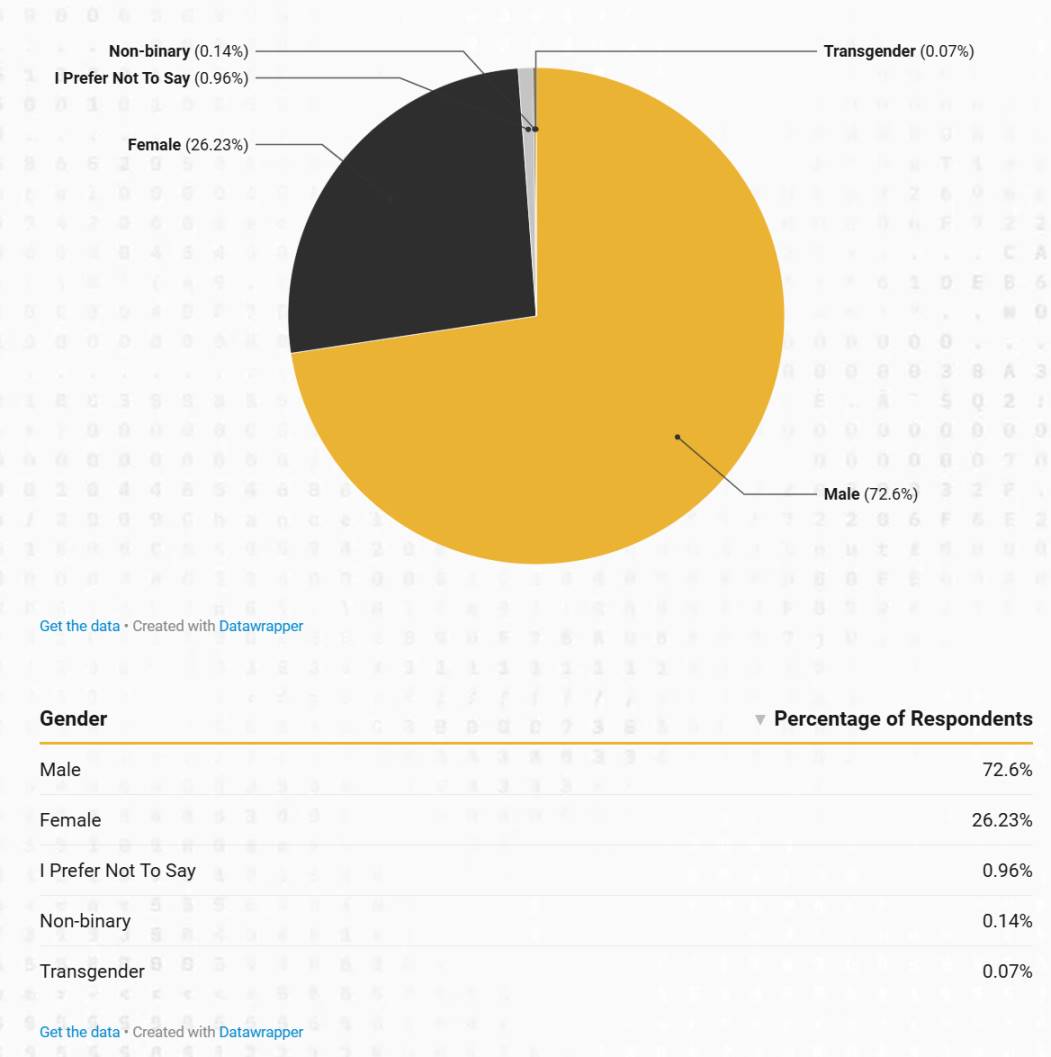
According to 2024 data, men make up 72.6% of the workforce, while women account for 25.9%. This distribution highlights the ongoing gender gap within the industry.
Increase in the Proportion of Stablecoin Salaries

Key Finding: Last year, 3% of people received their salaries in cryptocurrency, and this year that percentage has tripled to 9.6%.
In 2024, the proportion of people receiving salaries in cryptocurrency has increased from 3% in 2023 to 9.6%, doubling the previous figure. This growth highlights the trend of transitioning to digital asset compensation and the increasing popularity of stablecoin payment channels. Stablecoins are the preferred payment method for cryptocurrency salaries, with USDC and USDT dominating, and most people receiving their salaries in cryptocurrency choosing USDC.
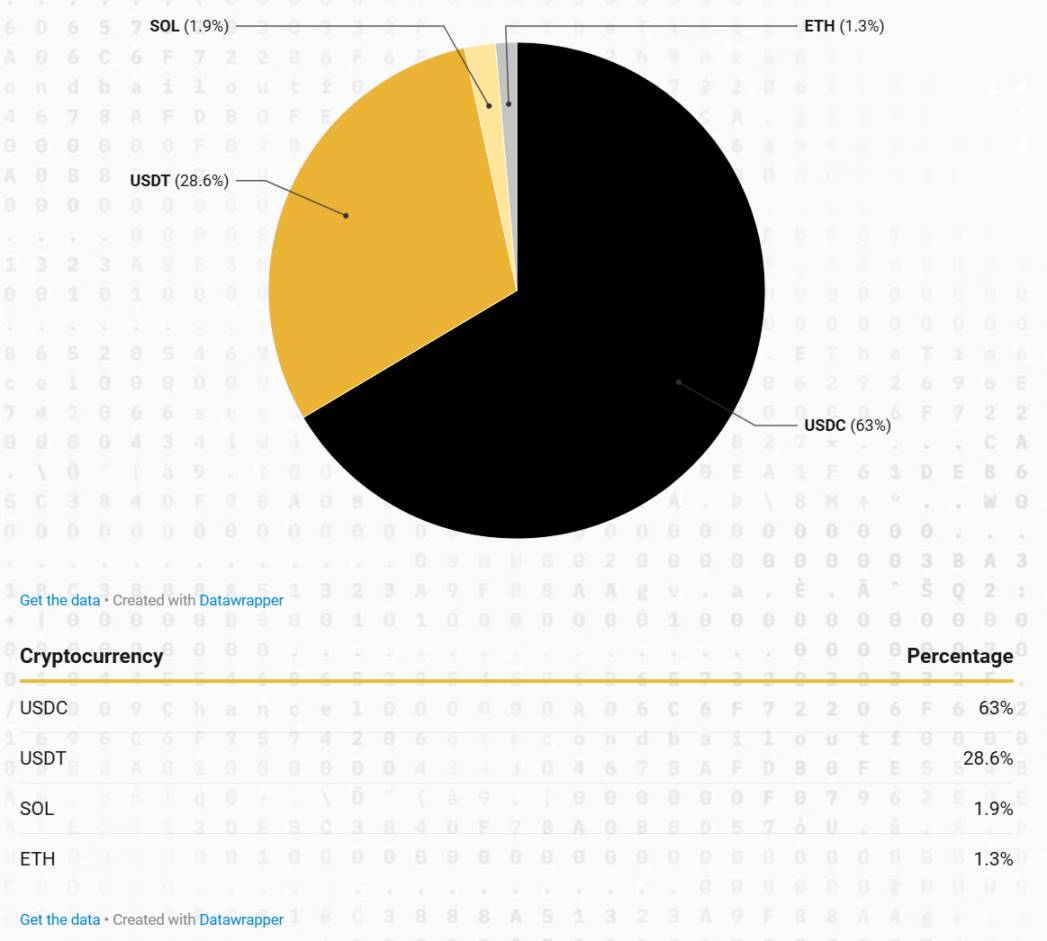
Stablecoins dominate:
● USDC (63%) and USDT (28.6%) together account for over 90% of cryptocurrency salaries, solidifying their position as stable and liquid compensation options.
● Non-stablecoin options (such as SOL and ETH) attract only a few individuals.
● Although USDT is the most traded stablecoin, USDC is more popular among employees. We initially thought this was related to the survey being more Western-oriented. Further research found that major salary providers (such as Deel, Remote, Rippling) do not currently support USDT payments.
The dominance of stablecoins in cryptocurrency salaries aligns with the overall trend in the industry. This data further validates the views of Mason Nystrom and Ryan Barney that stablecoins will become the next trillion-dollar opportunity. Their ability to connect traditional finance and the blockchain ecosystem makes them an increasingly important component of the crypto economy, applicable to both institutions and individuals. As the stablecoin sector progresses in innovation and regulatory clarity, more companies may adopt stablecoin payments for salaries in the future.
Ongoing Education in the Blockchain Field
Education Background and Salaries in the Blockchain Industry
This year, we examined the educational backgrounds within the industry and found some interesting results. An analysis of the education levels of blockchain professionals reveals trends regarding the economic returns of continuing education:
● Higher education may not yield returns:
○ On average, professionals with master's or doctoral degrees earn less than their counterparts with only a bachelor's degree.
○ Average salaries drop from $286,039 (bachelor's) to $214,359 (master's) and $226,858 (doctorate).
● Median salaries reflect similar trends:
○ The median salary for those with a bachelor's degree is $150,000, while for those with a master's degree, it is $148,500. This indicates that in the blockchain industry, continuing education may not lead to significant salary increases.
● Professional degrees do not guarantee higher salaries:
○ Although the median salary for doctorate holders is the highest ($200,000), the sample size is small. For many positions, industry experience and technical skills may be more important than formal educational credentials.
For professionals entering the blockchain industry, the economic returns from a bachelor's degree are the most significant. Continuing education (such as an MBA or advanced degrees) does not seem to increase average salaries, highlighting the industry's greater emphasis on skills, experience, and practical abilities rather than academic backgrounds. However, it should be noted that in certain fields (such as research and cryptography), continuing education still holds advantages.
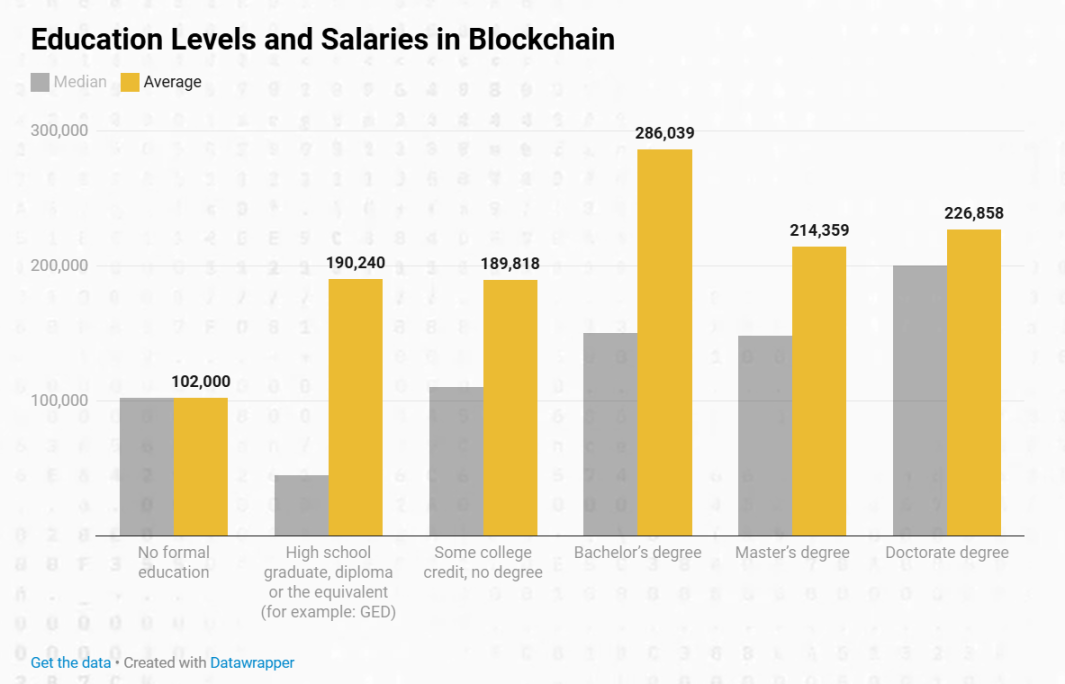
In most traditional industries, higher education levels typically lead to clear salary increases. For example, moving from a bachelor's degree to a master's degree usually results in about a 20% salary increase, while moving from a master's to a doctorate may yield an additional 15% increase.
In the blockchain field, there is a greater emphasis on practical skills and real-world experience rather than formal educational backgrounds. Self-taught developers and individuals from non-traditional backgrounds can still earn competitive salaries as long as they possess the necessary expertise. This focus on skills contrasts sharply with other industries: in 2022, individuals with a master's degree or higher had a median income that was 20% higher than those with a bachelor's degree.
Salaries
Executive and Founder Salaries
For executive positions, salaries increase as companies mature. At the seed stage, the average base salary is $146,579, with a median of $120,000. After entering Series A, salaries rise to an average of $201,735, with a median of $200,000. In the Series B stage, the average salary increases to $211,967, with a median reaching $225,000. By the Series C stage and beyond, executive compensation significantly increases, averaging $274,427, with a median of $293,204, reflecting the higher financial stability and growth potential of later-stage companies.
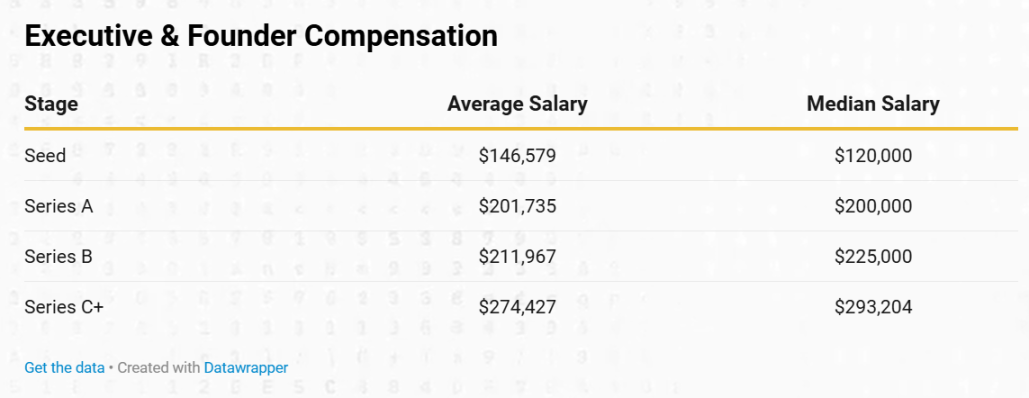
Engineering
Significant Salary Growth in Engineering, Especially for Junior and Mid-Level Positions
Salaries for engineering roles have increased at all levels, with the most significant growth seen in junior and mid-level positions. The median salary for junior engineers has risen from $110,000 in 2023 to $148,021 in 2024, an increase of 25.6%, reflecting high demand for entry-level talent. Mid-level engineers also saw a significant salary increase of 14.5%, reaching $176,000, while senior engineers experienced a more moderate salary growth of 4.9%, reaching $202,500, indicating that salary growth is stabilizing at higher levels.

Salaries also vary by company stage, with later-stage startups typically offering higher compensation. The median salary for seed-stage companies is $155,000, while Series A companies are slightly lower at $147,969, but the average salary is higher ($152,579), indicating a broader salary range. Series B companies lead in compensation, with a median salary of $198,000 and an average of $201,436, reflecting their stronger financial position.

Overall, junior engineers see the fastest salary growth, mid-level positions remain a key investment focus for companies, and while senior engineers have higher salaries, their growth is slower. Later-stage startups typically offer more competitive salaries, but early-stage companies compensate with more substantial equity and token rewards.
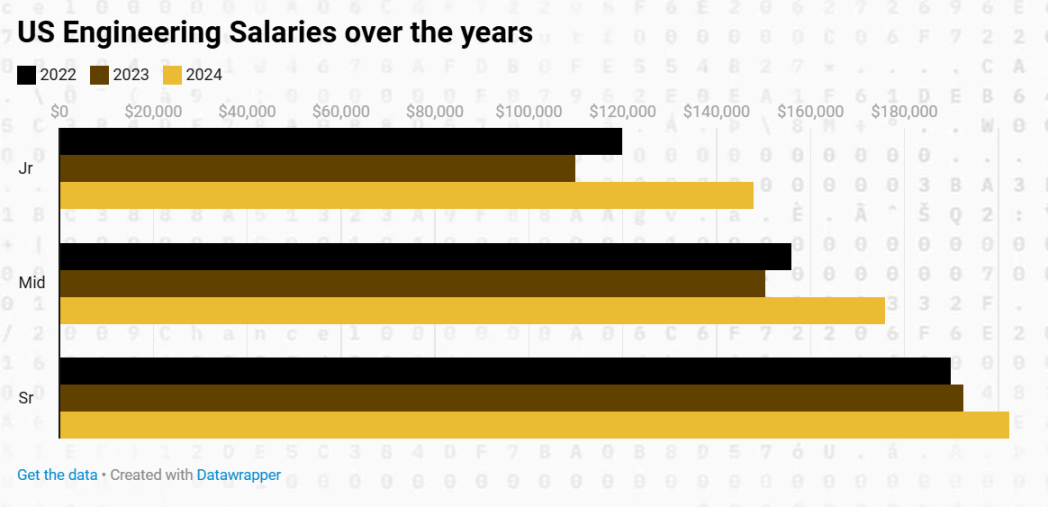
Product
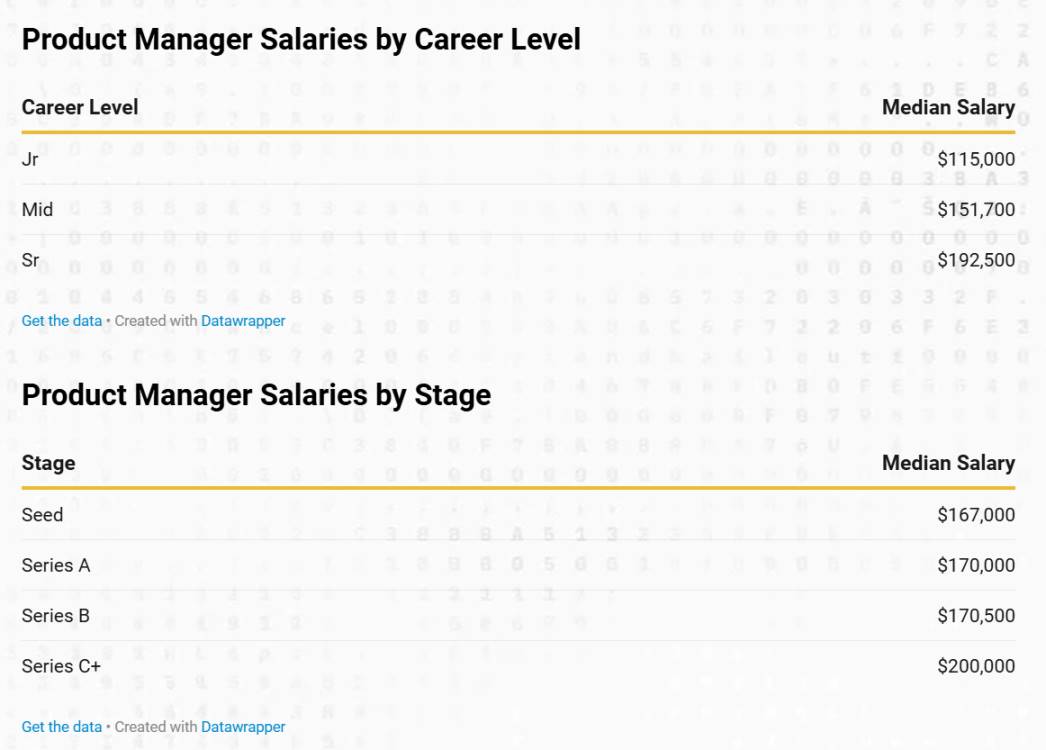
The median base salary for junior product managers is $115,000, for mid-level it is $151,700, and for senior it is $192,500.
From the perspective of company stage, salaries increase as companies develop. The median salary for seed-stage companies is $167,000, while Series A and B companies are slightly higher at $170,000 and $170,500, respectively. By the Series C stage and beyond, salaries reach $200,000, reflecting the stability and growth of mature companies.
Go-to-Market (GTM)
Marketing, Sales, Business Development
The average base salary for junior marketing positions is $102,500, with a median of $114,996. For mid-level positions, the average is $145,336, with a median of $140,008. Senior positions have an average of $187,188, with the median climbing to $200,000. This tiered structure reflects the salary growth in marketing roles as experience and responsibility increase.

Marketing
In terms of job level, the median base salary for junior marketers is $70,000, with an average of $78,133. Mid-level professionals have a median of $123,500 and an average of $127,167, while senior marketing positions have a median of $191,000 and an average of $185,147.
From the perspective of company stage, the median salary for seed-stage organizations is $145,000, while Series A companies drop slightly to $120,000. Series B companies have a median of $142,008, and Series C rises back to $145,000. Salaries continue to grow in the Series C stage and beyond, with Series C+ at $155,000 and Series D+ at $185,000. The overall median salary across all stages is $140,000, with an average of $145,725.
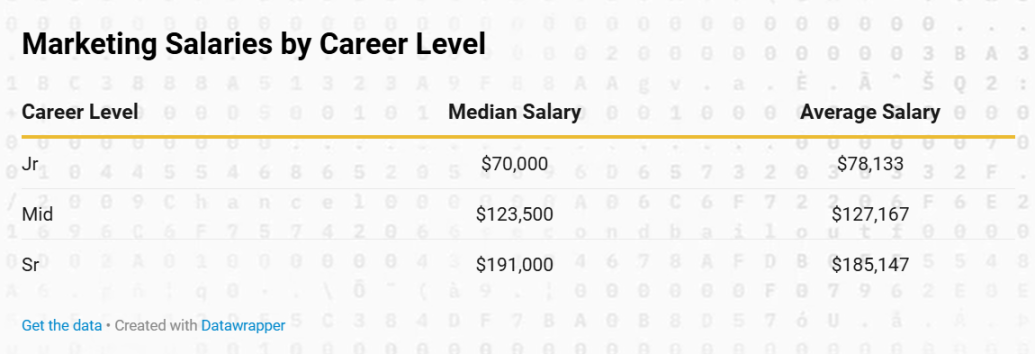
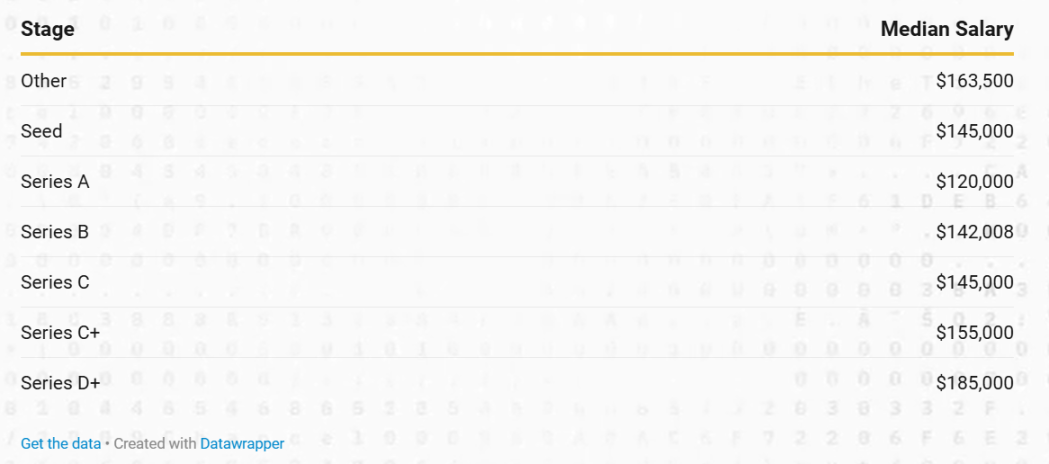
Business Development
Salaries for business development positions show significant growth both by company stage and job level. The median base salary at the seed stage is $40,000, rising to $150,000 at Series A, $168,000 at Series B, and $223,533 at Series C. In terms of career progression, the median for junior positions is $114,996, for mid-level it is $150,000, and for senior it is $160,000.
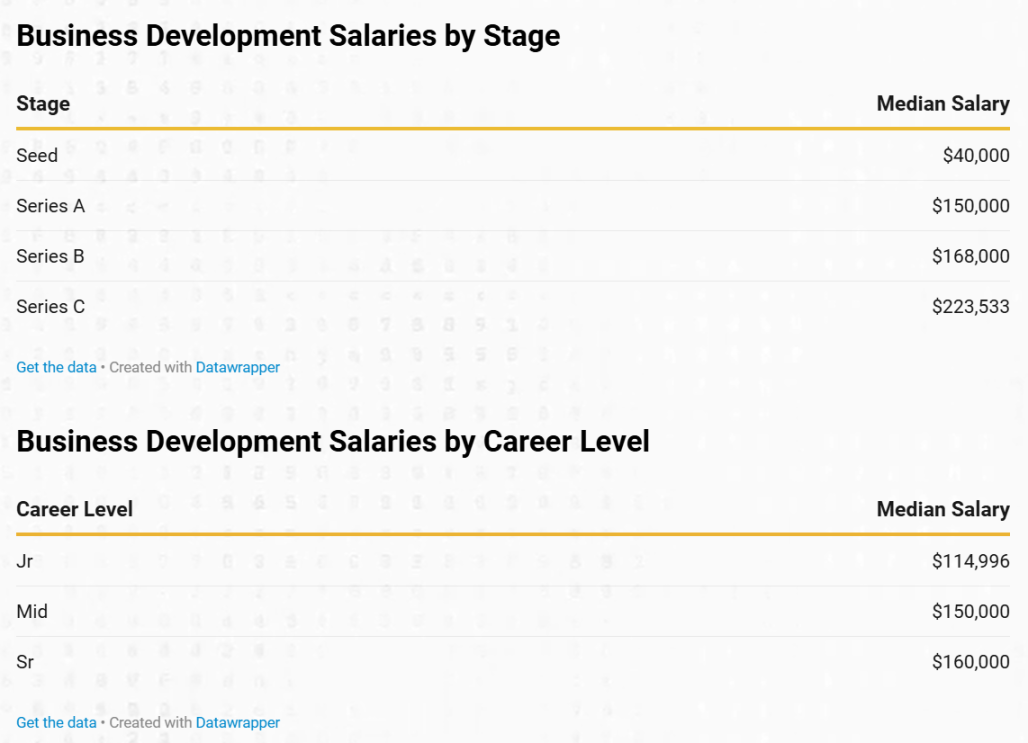
Finance and Accounting
In 2024, the average salary for junior finance and accounting positions is $106,500, with a median of $97,500. For mid-level positions, the average is $137,500, with a median of $135,000, while senior positions have an average of $256,020 and a median of $250,000. These figures clearly demonstrate the gradual increase in compensation with experience and position advancement.

Operations
The median base salary for junior operations personnel is $92,500, for mid-level it is $121,000, and for senior it is $195,000. This growth aligns with the increase in experience and responsibility.
From the perspective of company stage, base salaries increase as companies mature. Seed-stage companies offer $146,000, Series A offers $165,000, and Series B offers $157,500. By the Series C stage, salaries leap to $245,000.
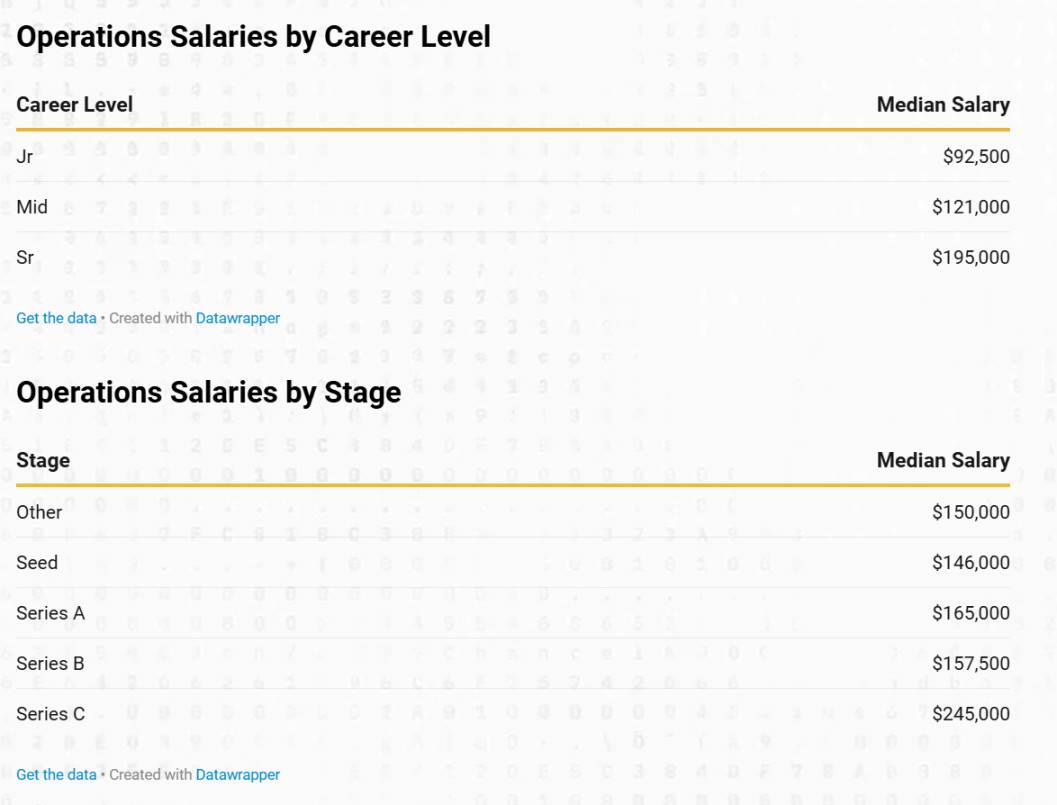
Legal
Salaries for legal positions typically increase as companies progress through funding stages. At the Series A stage, the median base salary is $178,750, rising to $199,500 at Series B. By the Series C stage, salaries for legal professionals significantly increase to $305,000. These figures illustrate how legal position salaries grow in tandem with company growth and maturity.
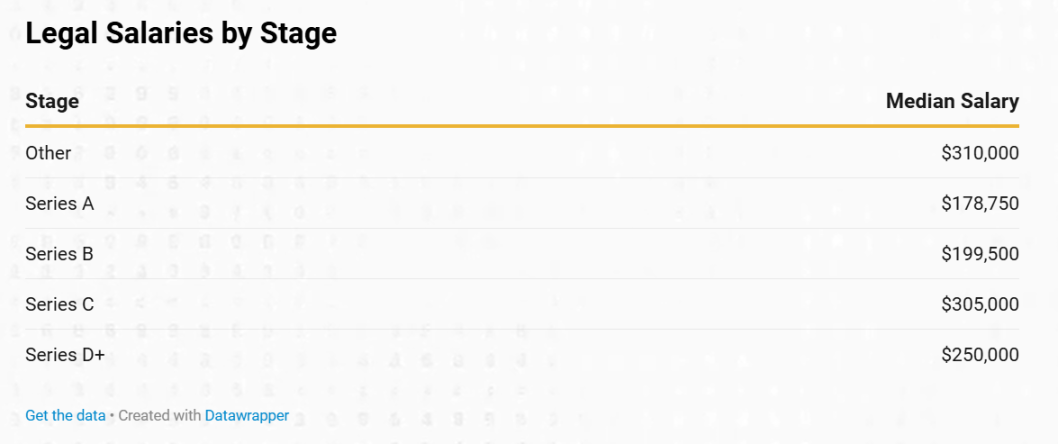
Token Incentives
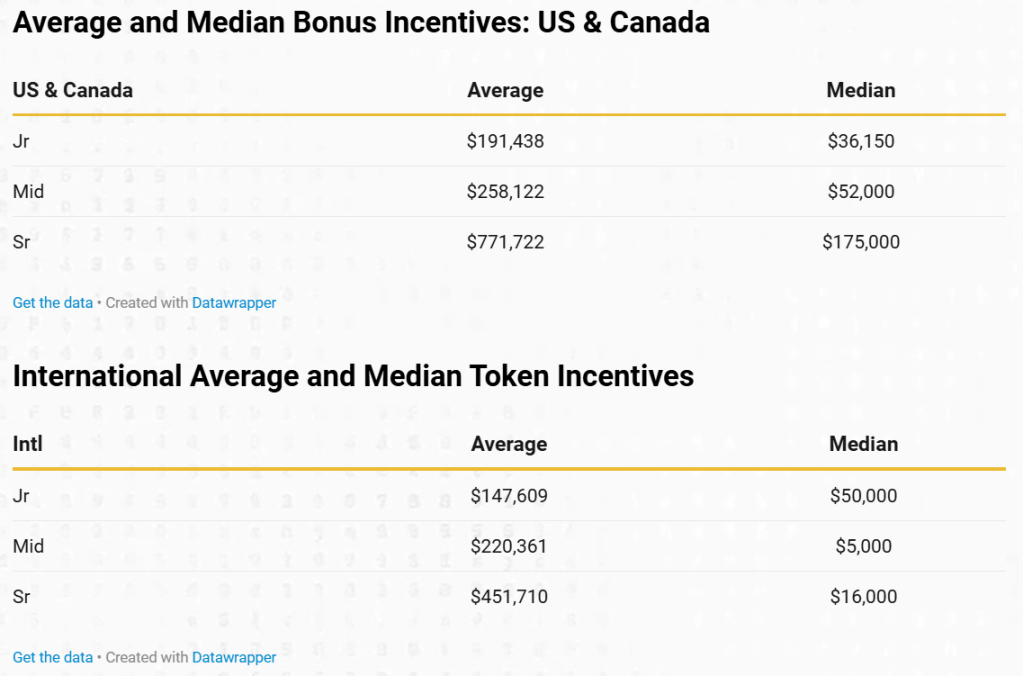
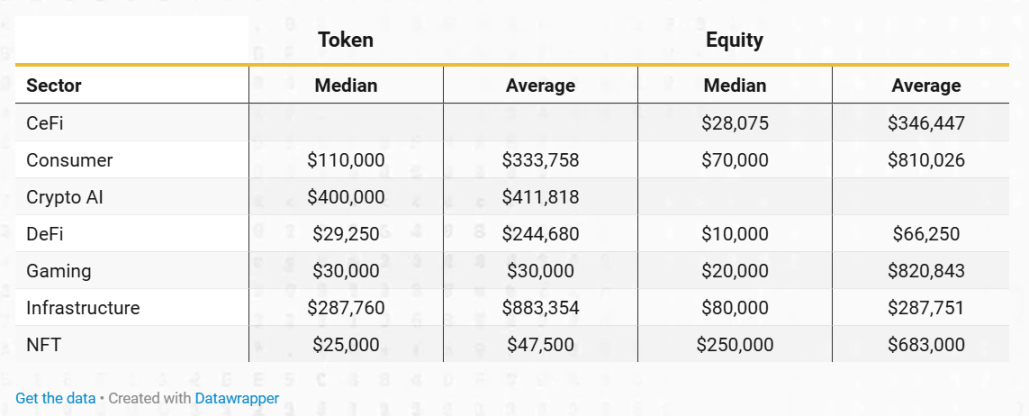
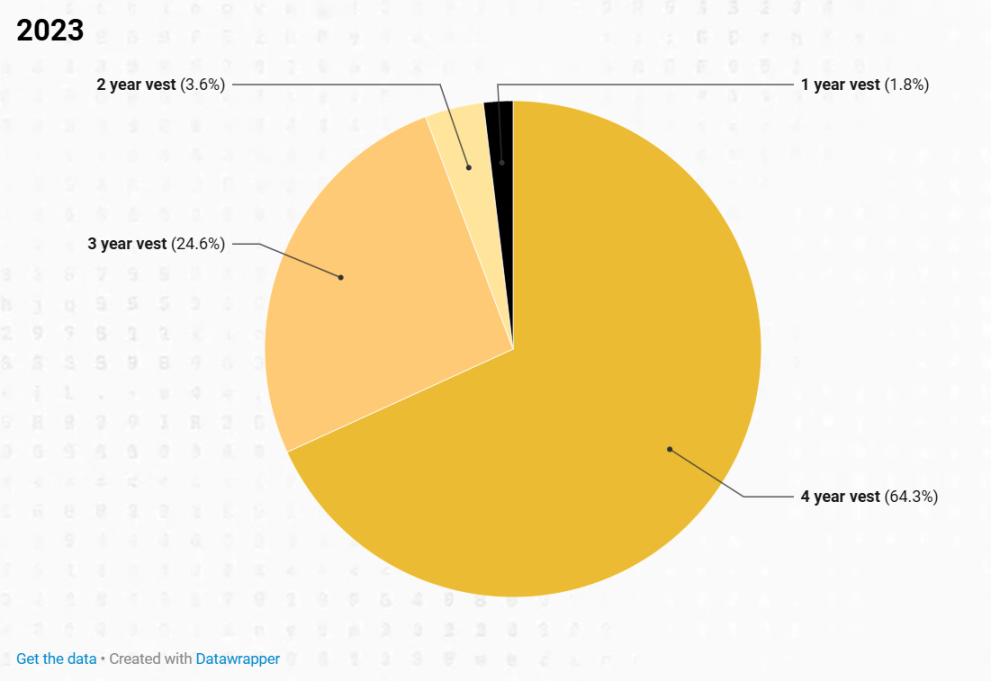
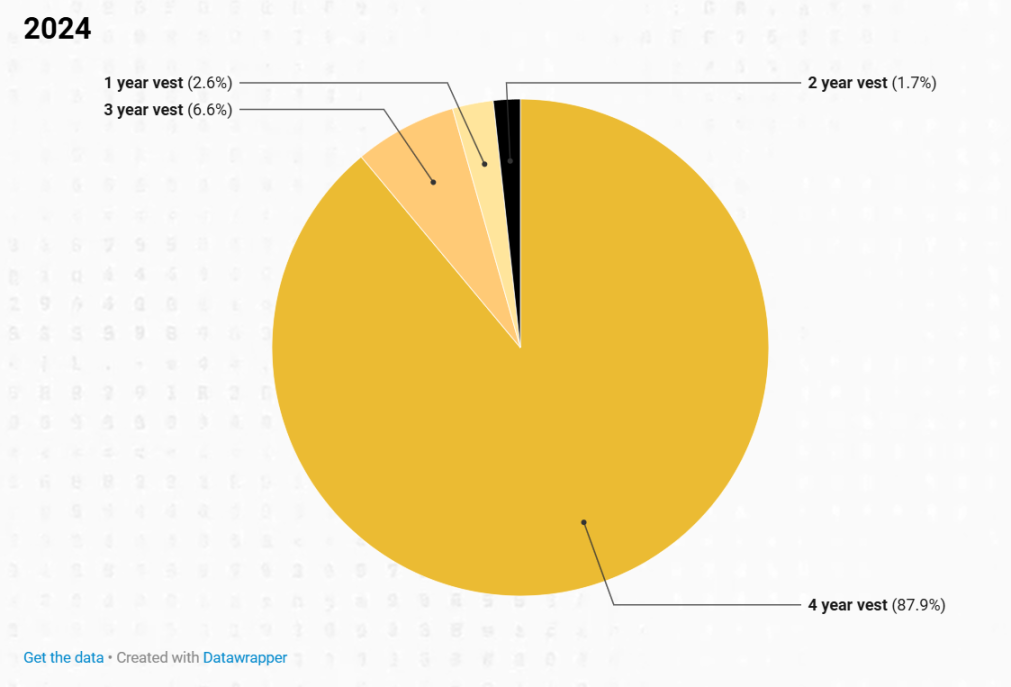
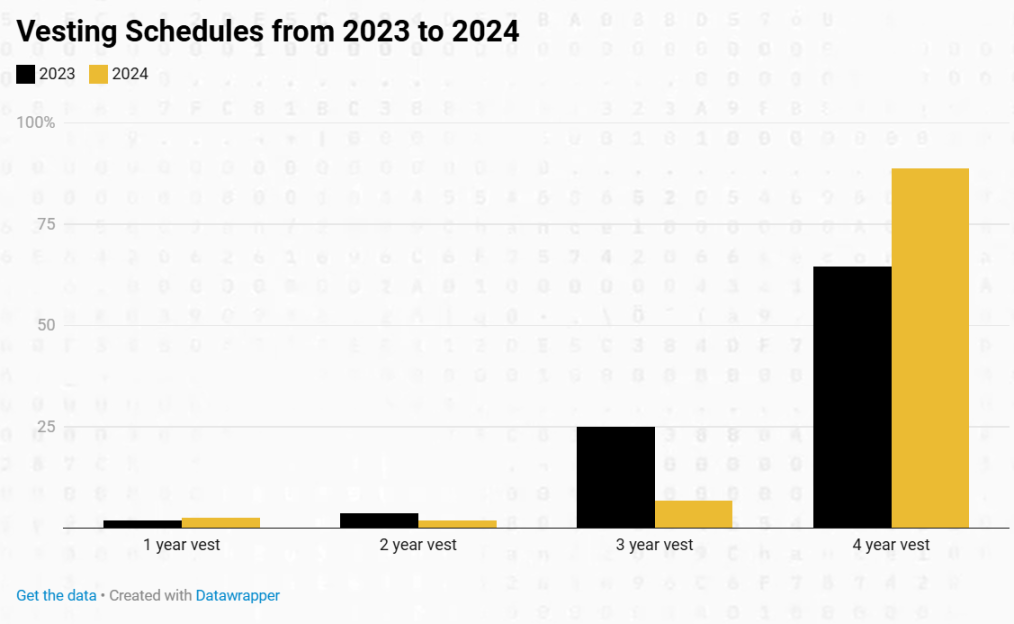
The vast majority of token lock-up periods are four years, increasing from 64.3% in 2023 to 87.85% in 2024. In contrast, shorter lock-up periods (one year, two years, or three years) account for a smaller proportion. In 2023, they ranged from 1.80% to 24.60%, while in 2024, they range from 1.72% to 6.58%. This data indicates a clear market preference for longer lock-up periods, especially in 2024.
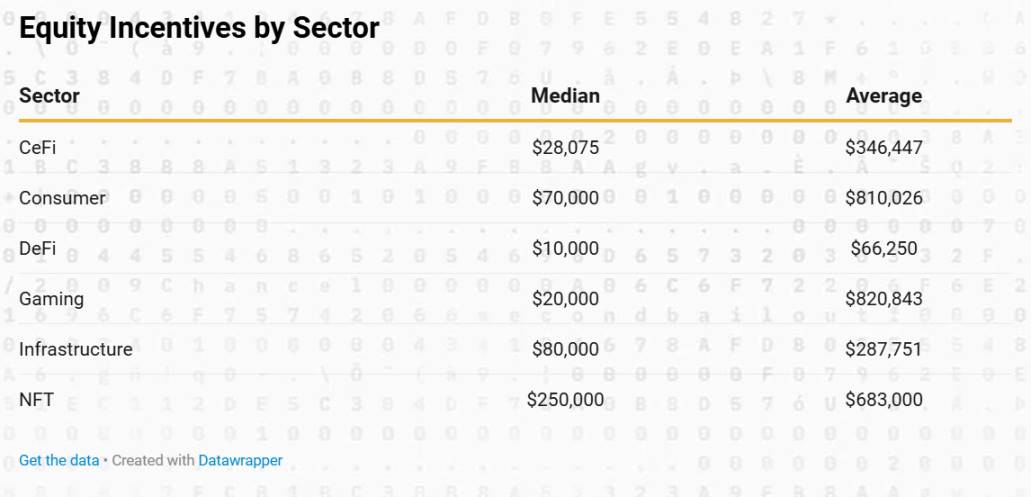
Median equity incentives vary by sector. DeFi projects have the lowest at $10,000, CeFi at $28,075, and gaming at $20,000. Consumer-centric sectors have median equity incentives of $70,000, while infrastructure stands at $80,000. The NFT sector has the highest median equity incentives, reaching $250,000.
Gender Pay in the Cryptocurrency Sector
On average, women's salaries are slightly higher than men's, except for executive positions. From a median perspective, women earn more in marketing, operations, and business development, but not in engineering and executive roles.
Our research engineer Ally Zach analyzed this:
"The median salary of full-time female cryptocurrency employees in the U.S. is about 14% higher than that of men, but this difference may be due to various factors. Women in the industry often have more work experience, which may explain part of the salary difference. Additionally, although not statistically significant, women are more likely to hold administrative and operational positions, which typically have lower base salaries than technical and non-executive roles. However, women may also hold a higher proportion of high-paying management positions, which could lead to higher initial base salaries. In the long run, though, men may earn more due to greater access to equity or token compensation. Men are generally more proactive in negotiating for equity or token compensation in the crypto space, often resulting in lower base salaries but greater long-term income potential. However, due to the variability of additional compensation data, it is difficult to draw definitive conclusions about the overall income differences between genders."
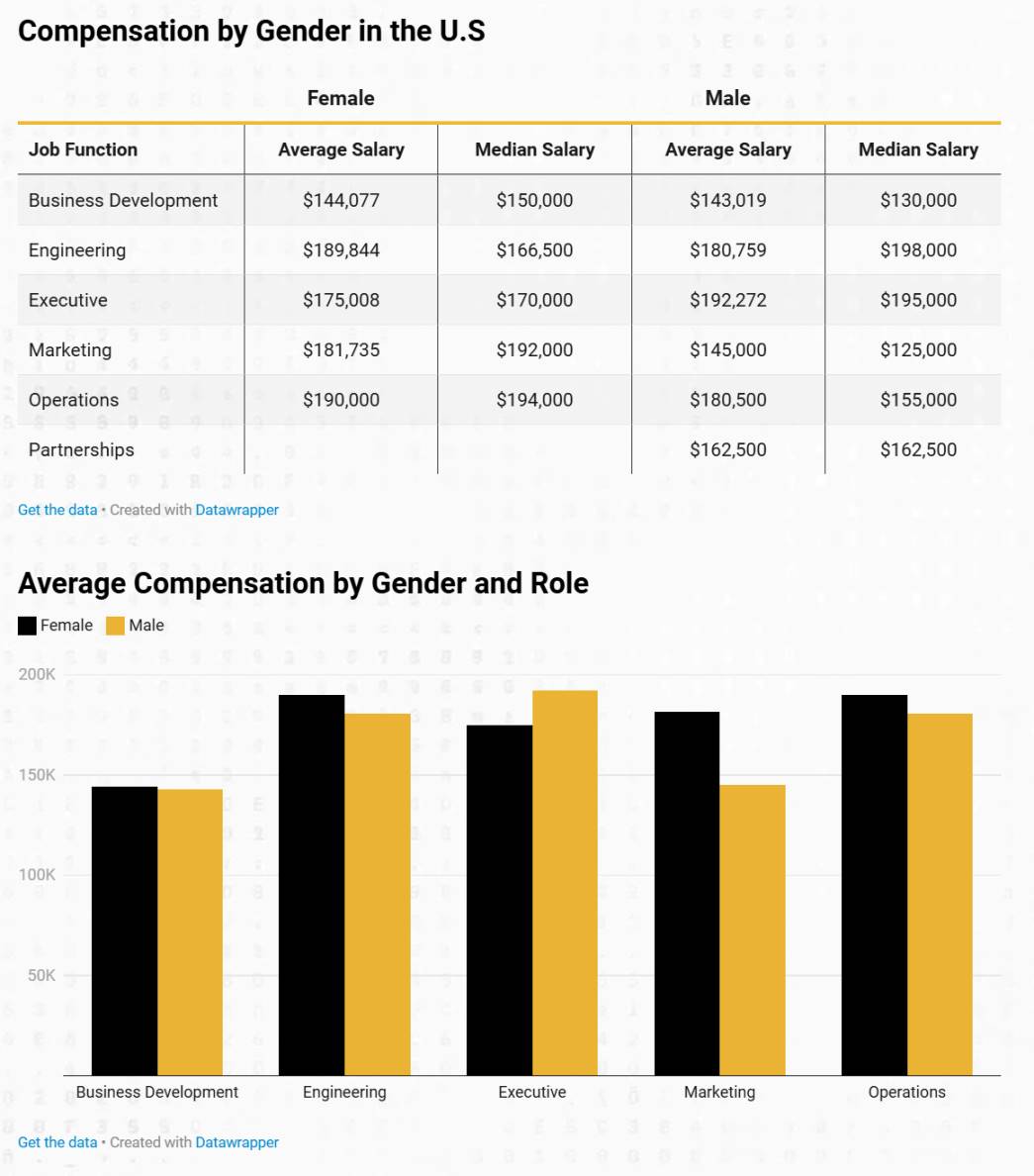
Conclusion
Our goal is to support portfolio companies and the success of the entire cryptocurrency ecosystem. In this process, we found a lack of sufficient salary databases within the industry and hope this survey can take the first step toward enhancing salary transparency in cryptocurrency.
We believe in the "causal power" embodied by the blockchain industry. In this spirit, we will share anonymized datasets with all participants. We believe that by providing such data, the industry will make better hiring and compensation decisions, leading to greater success for everyone.
免责声明:本文章仅代表作者个人观点,不代表本平台的立场和观点。本文章仅供信息分享,不构成对任何人的任何投资建议。用户与作者之间的任何争议,与本平台无关。如网页中刊载的文章或图片涉及侵权,请提供相关的权利证明和身份证明发送邮件到support@aicoin.com,本平台相关工作人员将会进行核查。




